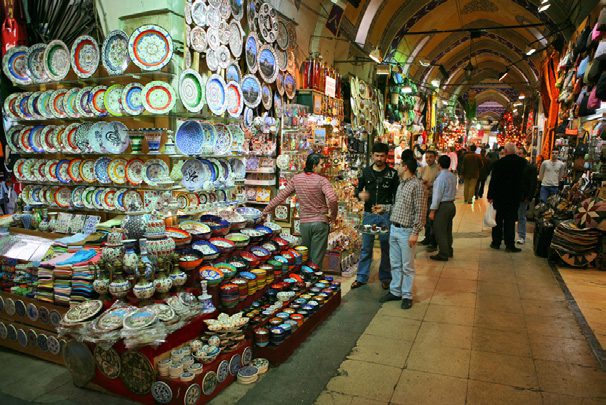
Cargo vessels, galleons, luxury yachts, fishing boats, ferries, it’s a busy channel yet totally enchanting. The old fortress still guards the narrowest point while scenic bays and seafood restaurants beckon along the shores. Regular ferries and tourist boats offer a variety of trips from the Eminönü docks.
For the people of Istanbul, Eminönü is the heart and soul of the city, ferry boats, anglers, street vendors, the double-decked Galata bridge spanning the Golden Horn, the iconic tower with splendid views over the Bosphorus, the floating kitchens bobbing near the shore, garlanded in lights as dusk falls over a skyline bristling with minarets and domes. In 1923, the capital was moved to Ankara but the magic did not fade: ‘The best thing about Ankara,’ said a Turkish poet, ‘is the way back to Istanbul.’
After such overwhelming opulence, the Blue Mosque feels like a breath of fresh air with its vast arcaded courtyard and cascading domes topped by slender minarets above the shores of Marmara. Even the sultan had to bow his head to pass through the gate and inside, the lofty prayer hall oozes peace and simplicity, flooded in natural light. Only the marble mihrab and elaborate pulpit add a touch of grandeur to the ancient calligraphy on pillars and domes.
Worshippers prostrate on donated carpets while the sun filters through 260 stained glass windows, lighting up some of the 20 000 blue tiles which give the mosque its name. Colours have faded over time but one can only wonder at the young enlightened Sultan Ahmed who presided over the foundation ceremony in 1609, digging the earth with a velvet-handled tool until he was exhausted. Unlike the Palace, entrance is free but the mosque is closed to non-worshippers during daily prayers.
The Blue Mosque stands on the edge of Sultanahmet Square, once a Roman Hippodrome holding up to 100,000 spectators who gathered to watch the games as silken banners fluttered around the Imperial Loggia. Wild beasts and chariots have long gone but today the square is graced by a pretty gazebo-style fountain and obelisks and columns rising through the greenery. Most unusual is the Serpentine Column, depicting three intertwined but headless snakes, brought from Greece by Constantine the Great.
At the other end of the square, Hagia Sophia is easily recognized by its red wall and minarets. Restored and converted into a mosque by Mehmet the Conqueror, it had been the world’s largest cathedral for 1000 years, a monumental feat at the time of construction, now a dark cavernous museum where Byzantine mosaics mingle with Koranic verses.
Near the city walls to the north-west, the Chora Monastery went through a similar fate but the finely restored mosaics and frescoes are well worth a detour and the smaller setting, though busy at times, is truly inspiring. A few steps away, traditional Ottoman houses cling to the hillside with upper floors overhanging the lanes and windows draped in wrought iron grilles. Potted plants enhance the façades painted mint green, deep red, sky blue or creamy white, visitors sip fresh orange juice under the trees and on the edge of the square, souvenir sellers wait for the afternoon siesta.
But there’s no time for siesta in the Grand Bazaar where over 4,000 shops jostle cheek by jowl in a grid of 60 streets or so. Rebuilt and extended several times since the 15th century, this is one of the world’s largest covered markets, a dizzying kaleidoscope of colours, sounds and smells shared by over 200,000 visitors a day. It defies imagination but within a few moments, you are caught under the spell, wandering from lane to lane, marvelling at hand-painted ceramics, silver and gold, carpets, textiles, leather and multi-coloured lanterns brushing your hair as you go past. The air smells of spice and apple tea, water pipes bubble and locals and visitors bargain for amber beads, gilded icons, copperware, embroidered slippers, leather, antiques, carpets or mother of pearl. This is a city within a city with its own marble fountains, cafés, hammam and mosques. The Bazaar is open every day except Sunday and Bank Holidays, from 9 am to 7.00pm.



